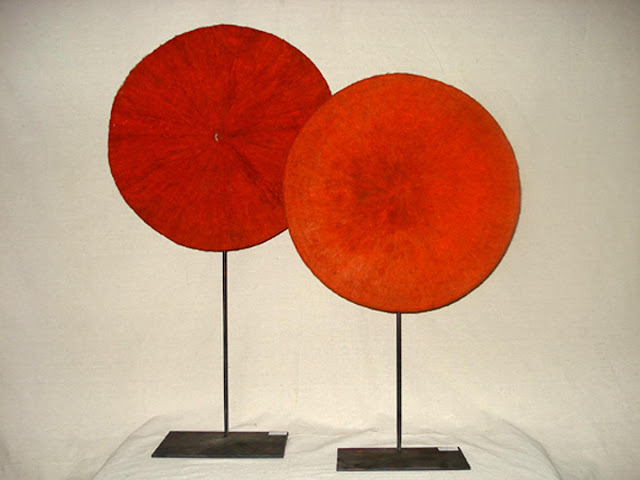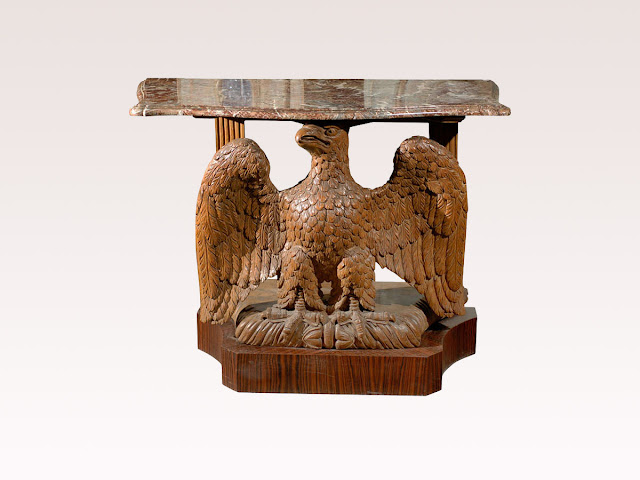Table: From the Latin word Tabula, which means a board, a plank, or a flat piece.
Not surprisingly, much like the history of chairs, the history of tables can be traced back to both Egypt and ancient China. Egyptian tables were often made of wood or stone and resembled pedestals more than they did what we would call a table today. Ancient Chinese tables were typically low to the ground so that they could be used by a culture where most people sat cross legged or knelt down to eat and do other tasks. These tables ranged from minimalist simplicity to exquisite intricacy and could be austere or bright and colorful depending on the wealth or stature of the owner.
 |
| Marble table found in Pompeii |
In ancient Greece tables were used mostly for dining and were typically of the single person variety, as opposed to longer, larger communal dinner tables we might recognize today. These tables were generally low to the ground and were often stored under Klinais, or the couches upon which Greeks often lounged. These tables came in a variety of configurations with three or four legs and featuring square, rectangle and round tops.
The Romans were early innovators in developing different tables for different uses. Their Mensa tables were similar to the Greek tables and were low and often found next to couches rather than under as the Greeks did with their Klinais. Roman Abacus tables on the other hand were usually higher and served a variety of functions from preparing meals, to woodworking to the display of jewelry or decorative objects. Marble was a particular favorite material for Roman tables and numerous examples of such were found in Pompeii and Herculaneum.
Although tables dated back to the ancient world, it was only with the coming of the 16th Century that they became common elements throughout much of Europe. Prior to that they were usually found in cathedrals and castles. Their decoration was often stark and they were typically of the trestle type, with thick plank tops and vertical planks for support. The tops of the tables were typically detachable as it was not uncommon to place and remove tables based on where a meal might be served, which might or might not be somewhere close to the kitchen. “Mobile” in this case should not be taken to mean lightweight however, as the tables were typically quite large and the planks and trestles could be quite heavy. (The French word for furniture is actually mobilier, signifying mobile.) At one end of the table would usually sit the head of the noble family and down the sides sitting on the benches would be the rest of the castle’s population with seating based on those with diminishing social rank sitting farther from the head.
 |
| Table prepared for dinner in Langelis in the Loire Valley |
In the 16th century as wealth found its way beyond the nobility and the church, tables became a more common element in many homes. The dining table began to develop into a less mobile element of a home and its place was the dining room, which again, might or might not be adjacent to the kitchen. Slowly the seating with the dining table evolved from benches to chairs, with armed chairs at the ends and armless chairs along the sides.
Not all dining tables were of the trestle type however, even as far back as medieval times. The four legged “joined table” with a top supported by connected at their feet by stretchers was also common. These tables were often quite large, and often could be expanded to increase capacity by the addition of draw leaves.
Simultaneously with the growth in tables as common household items was an increasing element of craftsmanship and beauty. This craftsmanship and artistic elements certainly showed up in the dropleafs, aprons and skirts, but nowhere more so than the legs. From simple straight often thick legs evolved the beauty of cabriole legs, Flemish scroll legs, fluted, reeded and saber legs among others.
Finally there are the materials. Tables, which typically consist of a flat, horizontal surface supported by any one of myriad different elements, are today probably the most varied elements of furniture found in homes. Aside from the typical dining tables, we have coffee tables, end tables, console tables, pier tables, wine tables, side tables, hall tables, dressing tables, card tables among many others. In addition to the wide variety of functions that tables represent, the materials from which they are made varies greatly as well. While wood remains the primary material from which tables are manufactured, the 20th century brought about a revolution in table manufacturing materials. Today common materials for tables are glass, metal, a variety of polymers, stone, fiberglass, Masonite, plastic and myriad combinations of all of those materials.
The result of this evolution is a design world where tables can be both the center of attention in a room or an accessory to enhance a room’s elegance and beauty. Regardless of the function at hand there is likely a table that is up to the task, both in design and function. It’s often said that form follows function… but with the ubiquity of table designs that isn’t necessarily true any longer. Thankfully for almost any function in any room there’s probably a table somewhere that fits the bill.
Portuguese Style Console Table
18th C. Italian Putti Console
Italian Mirrored Top Coffee Table.
Swedish Baroque Style Oval Table
A French Wine Tasting Table
18th C. Swedish Console Table
A Classical Period Hand Carved Console Table With Wooden Eagle
Pair of 19th C Swedish Demi-Lunes
A Swedish Early 19th Century Baroque Style Wooden Table
A French Early 19th Century Side Table.
A French Early 19th Century Wooden Console Table with Marble Top
A French 19th Century Old Stone Water Trough made into a Coffee Table
A Late 17th ~ Early 18th Century Wooden Brazilian Console Table
Teak Root Wooden Console Table from Indonesia.
Round Table with Carved Corinthian Painted Base and Round Glass Top
European Guéridon Table with Four Accompanying Stools
Swedish Mirrored Side Table
British Colonial Occasional Table in Gothic Style with Jigsaw Pattern Cutouts
Early 19th Century Italian Walnut Fratino Side Table
Round Pedestal Teak Wood Table
Large Size Gate-Leg Drop Leaf Table, Painted American Poplar
A Dutch Wooden Jeweler's Work Table.
Louis XV Style Dining Table
Round Center Table with Metal Fluted Column Pedestal and Steel Wrapped Wooden Top
French 19th Century Painted Wood Oval Accent Table
For our full selection of tables visit our website at
http://www.swedishantiques.biz/antiques/tables

























































